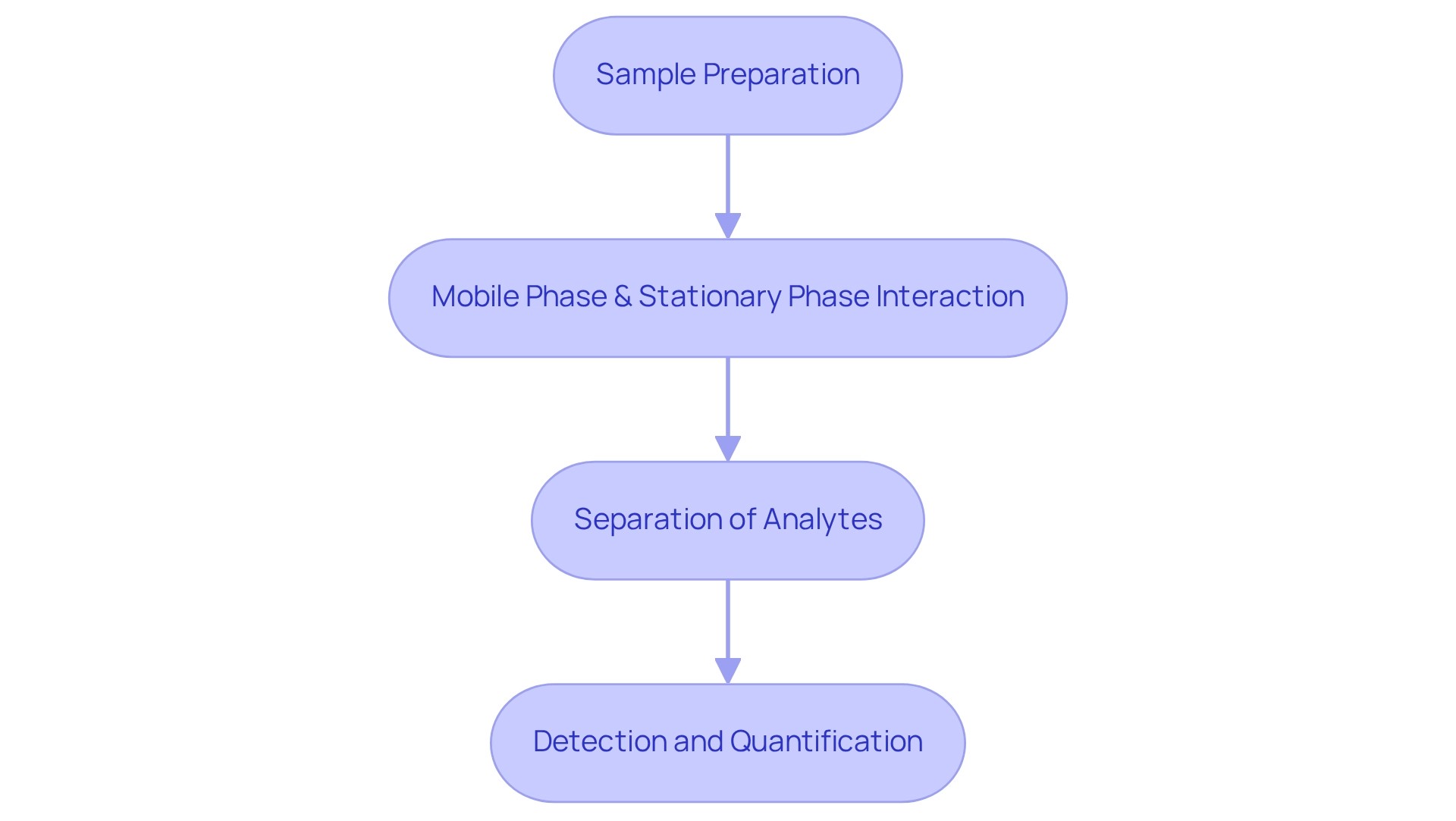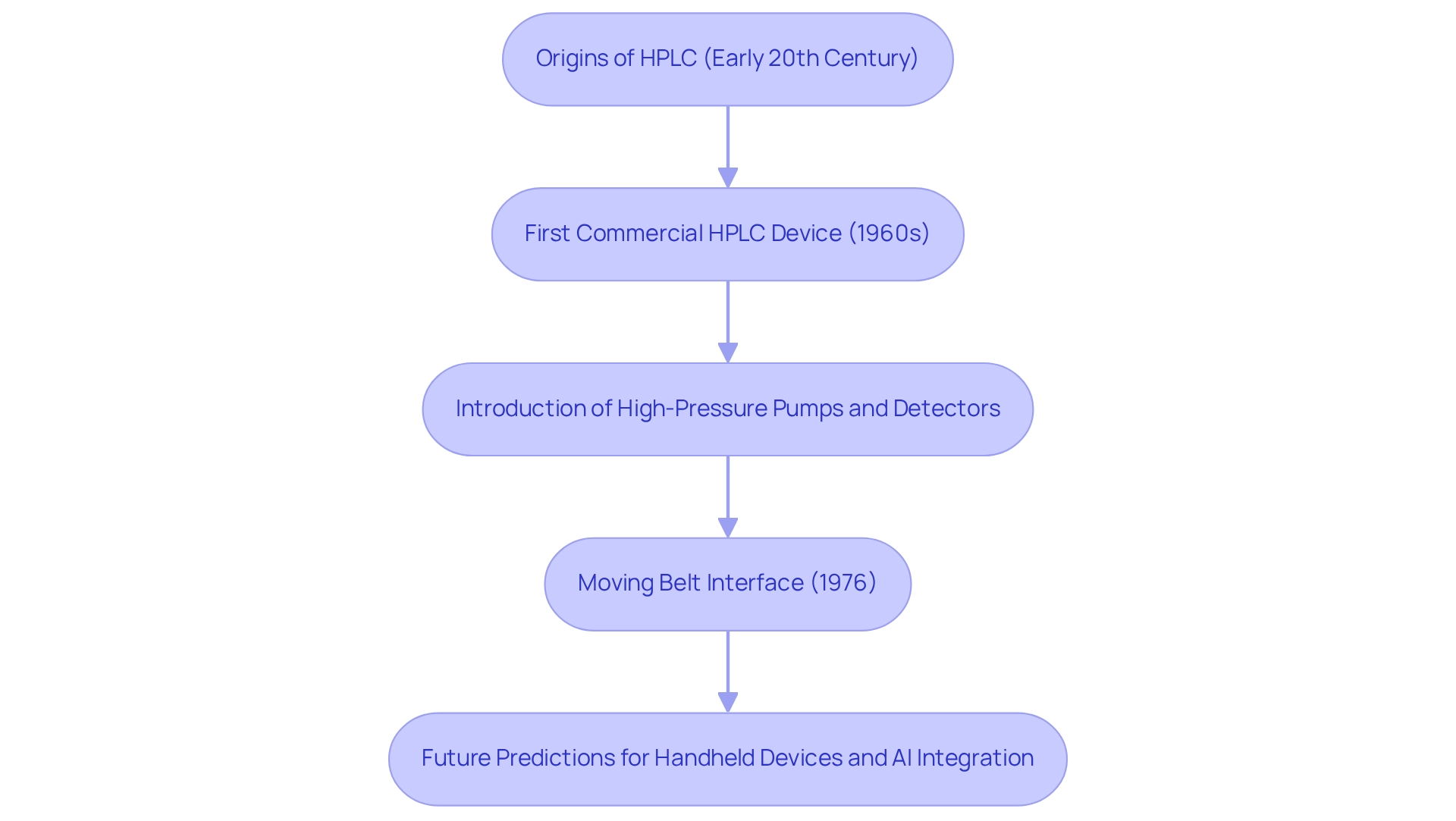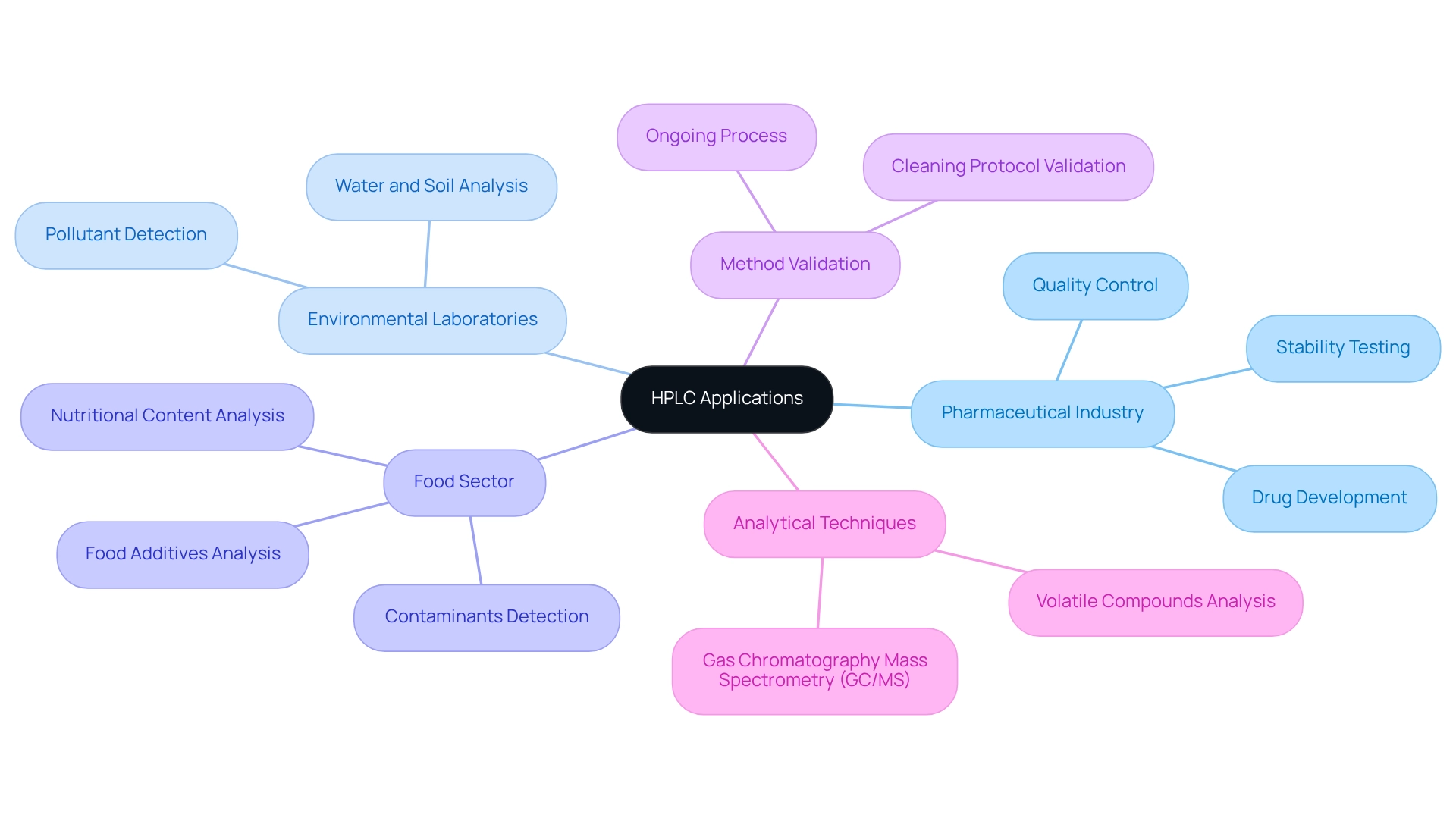Overview
This article delves into the principle of High-Performance Liquid Chromatography (HPLC), underscoring its essential components and diverse applications across various industries. HPLC operates by effectively separating analytes within a mixture, relying on the intricate interactions between a mobile phase and a stationary phase. Its practical applications span critical sectors such as:
- pharmaceuticals
- environmental testing
- food safety
Supported by significant technological advancements, HPLC enhances efficiency and precision, affirming its vital role in laboratory settings.
Introduction
In the realm of analytical chemistry, High-Performance Liquid Chromatography (HPLC) emerges as a formidable technique, essential for the separation, identification, and quantification of complex mixtures. Its origins can be traced back to early chromatography, yet HPLC has evolved into an indispensable tool across various industries, particularly in pharmaceuticals, environmental testing, and food safety. This article explores the fundamental principles that govern HPLC, its historical development, key components, and practical applications. Moreover, it highlights how advancements in technology—such as innovative detectors and enhanced column designs—continue to refine its capabilities. As the demand for precision and reliability in analytical results intensifies, grasping the intricacies of HPLC becomes crucial for professionals committed to ensuring quality and safety in their respective fields.
Define the Principle of High-Performance Liquid Chromatography (HPLC)
High-Performance Liquid Chromatography (HPLC) is an advanced testing method designed to separate, recognize, and quantify elements within a mixture. The principle of HPLC is fundamentally based on the separation of analytes between a mobile phase, usually a solvent, and a stationary phase, which consists of the material packed inside the column. As the mobile phase moves through the column, various compounds interact with the stationary phase to varying degrees, resulting in their separation based on distinct chemical properties.
HPLC is celebrated for its reproducibility and versatility, establishing it as an essential technique in analytical chemistry, particularly within the pharmaceutical industry. Current data underscore the effectiveness of high-performance liquid chromatography in analyzing drug products, with applications extending to environmental testing and food safety. For instance, in food analysis, HPLC is employed to separate and quantify both beneficial and harmful components in complex matrices, enhancing the ability to identify trace levels of compounds crucial for food safety assessments.
The optimal characteristics of a liquid chromatography detector include excellent stability and reproducibility, which are critical for ensuring accurate and reliable results. Recent advancements in HPLC technology as of 2025 have significantly bolstered its efficiency and effectiveness. Innovations in column design, such as the introduction of new materials and configurations, alongside improvements in detector stability, have enhanced separation capabilities, facilitating more precise analyses. Notably, the launch of Osaka Soda's NQAD, a groundbreaking aerosol-based detector, provides highly selective detection that surpasses traditional UV and MS detectors. This development allows for the capture of elements that may have been overlooked in previous evaluations, thereby enhancing the overall sensitivity and precision of HPLC applications.
Sample preparation for high-performance liquid chromatography is a vital component of the process, involving the purification of liquid specimens or the extraction of solid materials to eliminate interferences prior to analysis. This step is essential for obtaining accurate results and preserving the integrity of the analytical process, as it relates to the principle of HPLC, which emerges as a powerful analytical tool grounded in the effective separation of components in mixtures. Its applications across pharmaceuticals, environmental testing, and food safety underscore its importance in ensuring quality and safety across various industries, particularly with the incorporation of advanced detectors like the NQAD for enhanced testing performance.

Explore the Historical Development of HPLC
The origins of High-Performance Liquid Chromatography (HPLC) date back to the early 20th century, and they are deeply rooted in the principle of HPLC, which is based on the foundational invention of chromatography. A pivotal advancement in the principle of HPLC occurred in the late 1960s with the introduction of the first commercial HPLC device by Waters Associates, setting a new standard in chemical analysis. This innovation marked the beginning of a transformative era characterized by rapid advancements in separation technology, including the development of smaller particle sizes and enhanced stationary phases, significantly improving the efficiency and clarity of separations.
As the technology evolved, the introduction of high-pressure pumps and sophisticated detectors further revolutionized the principle of HPLC, solidifying its role as an essential technique in laboratories worldwide. Notably, in 1976, Finnigan MAT unveiled the moving belt interface, the first effective LC-MS connection that integrated liquid chromatography with mass spectrometry, thereby augmenting the evaluative capabilities of HPLC according to the principle of HPLC.
In this landscape, JM Science Inc. has been at the forefront, providing a comprehensive range of premium columns and accessories, including Shodex, CapcellPak, and Reprosil columns, along with Shodex Refractive Index and Conductivity detectors. These products cater to various scales of HPLC and are vital for optimizing laboratory workflows, emphasizing the principle of HPLC in the ongoing advancement that underscores the importance of staying updated on technological developments.
Predictions suggest a shift towards handheld devices for real-time health analysis and AI-integrated systems designed for streamlined user interaction, reflecting a broader trend towards more accessible analytical tools. Over the past 50 years, the principle of HPLC has undergone significant evolution, consistently adapting to meet the changing demands of the scientific community and enhancing its role in research and healthcare.

Identify Key Components and Characteristics of HPLC Systems
The principle of HPLC involves a standard high-performance liquid chromatography system that comprises several vital elements, such as:
- Solvent reservoir
- High-pressure pump
- Autosampler
- Chromatography tube
- Detector
- Data acquisition system
The solvent reservoir houses the mobile phase, which the pump delivers at a precise flow rate, ensuring consistent performance. According to the principle of HPLC, the autosampler injects the sample into the mobile phase stream, enabling automated and consistent sample introduction, while the chromatography tube, filled with stationary phase material, is where the separation occurs. JM Science Inc. offers a range of high-performance liquid chromatography columns, including Shodex, CapcellPak, and Reprosil, tailored for all scales of liquid chromatography applications. Furthermore, high-performance liquid chromatography fittings, manual injection valves, and the new Flom liquid chromatography degassers are available to enhance system performance.
In the principle of HPLC, as the sample elements interact with the stationary phase, they separate according to their affinities, resulting in distinct elution profiles. The detector, often referred to as the 'eyes' of the liquid chromatography system, quantifies the concentration of each substance as they elute from the column, providing critical data for analysis. Recent advancements in high-performance liquid chromatography technology have led to the development of gradient separations, which typically offer superior performance compared to isocratic modes, albeit with increased complexity and the need for advanced pump hardware. This underscores the importance of having access to educational resources and premium instruments, such as those provided by JM Science Inc., empowering laboratories to effectively utilize these advanced systems.
Finally, the data acquisition system records these results, enabling detailed examination and interpretation. Each element plays an essential role in ensuring the precision and reproducibility of analyses based on the principle of HPLC. For example, a tailing factor (T) of 1 indicates a symmetrical peak, while T values greater than 1 suggest tailing, and values less than 1 indicate fronting, which can impact the reliability of results. By understanding the role and significance of each component, laboratories can enhance their chromatographic setups, ensuring efficient and dependable analyses.

Examine Practical Applications of HPLC in Various Industries
High-performance liquid chromatography (HPLC) operates on the principle of HPLC, serving as a cornerstone technology across numerous sectors, renowned for its accuracy and reliability in testing outcomes. In the pharmaceutical industry, it is indispensable for drug development, quality control, and stability testing, ensuring adherence to stringent regulatory standards. Recent advancements indicate that total resolution of pharmaceutical formulations can be achieved in mere seconds; however, while research findings in liquid chromatography and ultra-high-performance liquid chromatography (UHPLC) are promising, they may still require further validation for extensive analytical applications or quality control.
This context underscores the efficiency of HPLC in critical environments, such as pharmaceutical production and testing, illustrating the principle of HPLC. Environmental laboratories employ this method to detect and quantify pollutants in water and soil samples, significantly bolstering environmental protection initiatives. This technique is essential for monitoring contaminants, thereby safeguarding public health and preserving ecosystems.
In the food sector, the principle of HPLC is utilized to analyze food additives, contaminants, and nutritional content, ensuring food safety and compliance with health regulations. Additionally, the principle of HPLC extends to vital applications in pharmaceuticals, where it plays a crucial role in method validation—a continuous endeavor rather than a singular event. For instance, utilizing HPLC to validate cleaning protocols for manufacturing equipment necessitates a comprehensive evaluation of linearity, particularly at the lower end of the potency assay range. This ongoing assessment is critical for maintaining compliance and ensuring the reliability of analytical results.
Case studies highlight HPLC's effectiveness in analyzing volatile compounds through techniques such as Gas Chromatography Mass Spectrometry (GC/MS), commonly used in pharmaceutical testing and research. GC/MS complements liquid chromatography by offering a robust method for analyzing volatile substances, thereby enhancing overall analytical capabilities in pharmaceutical applications.
As the landscape of HPLC evolves, the principle of HPLC in its applications for environmental testing and food safety remains vital, solidifying its status as an invaluable asset in research and quality assurance across diverse fields.

Conclusion
High-Performance Liquid Chromatography (HPLC) is an essential analytical technique, recognized for its capability to separate, identify, and quantify complex mixtures. By utilizing the interaction between analytes and a stationary phase, HPLC delivers precision and versatility, rendering it indispensable in pharmaceuticals, environmental testing, and food safety. Recent advancements, including innovative detectors and enhanced column designs, have further augmented its analytical capabilities.
The historical evolution of HPLC showcases significant milestones, such as the introduction of high-pressure pumps and the integration of mass spectrometry, which have broadened its applications. As technology advances, the emergence of user-friendly devices, including handheld and AI-integrated systems, signifies a trend toward greater accessibility in analytical chemistry.
Key components of HPLC systems, from solvent reservoirs to data acquisition systems, are crucial in ensuring accuracy and reliability. Innovations in gradient separations and the availability of advanced instruments empower laboratories to fully harness HPLC’s potential.
In conclusion, HPLC serves as a cornerstone technology across diverse industries, facilitating drug development, environmental monitoring, and food safety assessments. Its ongoing evolution and the incorporation of cutting-edge technology underscore its importance in addressing the increasing demands for precision and reliability in analytical outcomes. As the focus on quality and safety intensifies, HPLC will undoubtedly remain an invaluable tool in the realm of analytical chemistry.




